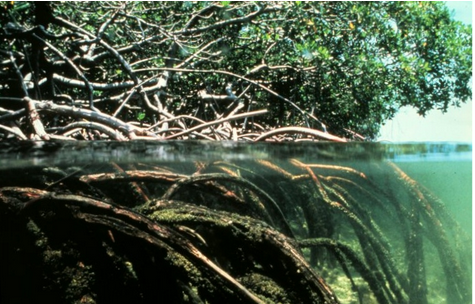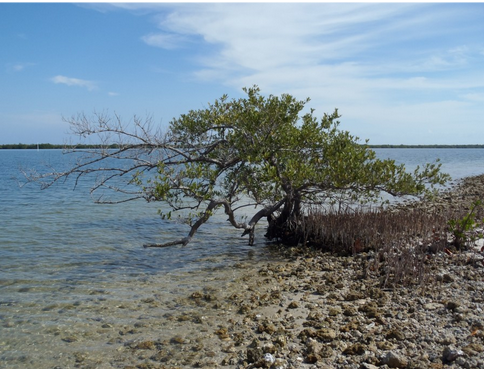More than 15 species of mangrove inhabit both East and West Africa and contribute greatly to the diverse ecosystem. Mangrove forests are found in 10 of the 17 West African countries, including Senegal and Nigeria1. Globally, one fifth of all mangrove forests have been lost since 19802. In Western Africa, the decline has been especially severe. Urban expansion, need for charcoal, fuel wood, and land for agriculture have greatly diminished the mangrove populations.

Mangrove Benefits
Mangrove forests support communities both above and below the water. Neighboring communities utilize mangroves in so many ways. Mangrove honey, wood for construction, firewood, and traditional medicine are just some of the uses. Mangroves also act as a nursery for many fish species. Shellfish, mollusks, and fish are found using the mangroves roots as protection. This also helps to provide communities with a consistent food source. In addition to supporting biological diversity, mangroves absorb and disperse tidal surges and serve as shelter against extreme weather2.As West Africa’s population continues to grow, communities are relying more and more on the benefits of these mangroves.

Urban expansion, charcoal, fuel wood, and land for agriculture pose a serious threat to mangrove forests in West Africa. Overall, deforestation, along with rising sea levels and erosion represent significant and growing threats to mangroves globally. Increasingly, these forests are now also being converted into shrimp farms. This practice had most recently been occurring in Southeast Asia and Latin America. However, now is becoming an increasing threat to East Africa, accounting for 25% of all destruction2. Communities are being directly affected by the exploitation of their mangrove forests, leading to decreasing food sources and weather protection.
Guinea Mangroves
Guinea is a country experiencing a direct hit from the loss of mangrove populations. “The accelerated rate of conversion of mangrove forests to rice in Guinea has, according to Bertrand (1993) and Wolanski and Cassagne (2000), resulted in irreversible damage to these forests”4. Although much of the damage is irreversible, organizations are bringing new practices to these communities. Guinea has also shown efforts to regain the mangrove population in this region. Restoration of mangrove populations along the coast have been conducted in multiple other coastal nations along the Gulf of Guinea. This will help local communities restore and better manage their mangroves.

The Wetlands International organization is supporting these communities by bringing new practices to help manage their mangroves. To decrease the pressure on mangroves to support local communities, new techniques which, for example, help reduce the need for mangrove wood, are being introduced3. Communities within Guinea continue to learn and implement these new practices. With the help of other organizations, the threat of continued reduction of these mangrove forests will hopefully decrease. The increasing knowledge will soon set an example as to how the mangrove forests of the world should be managed. Additionally, there are already populations of mangrove forests within protected areas, which will expand to cover greater areas.
Sources
http://africa.archive.wetlands.org/Africanwetlands/Mangroves/tabid/2938/language/en-GB/Default.aspx
1https://eros.usgs.gov/westafrica/mangrove
2http://africa.archive.wetlands.org/Africanwetlands/Mangroves/tabid/2938/language/en-GB/Default.aspx
3http://africa.archive.wetlands.org/Whatwedo/Mangrovescoasts/tabid/2943/language/en-GB/Default.aspx
4https://www.researchgate.net/publication/225405788_An_Assessment_of_Mangroves_in_Guinea_West_Africa_Using_a_Field_and_Remote_Sensing_Based_Approach/download
Photo Sources:
https://commons.wikimedia.org/wiki/File:Mangroves.jpg
http://africa.archive.wetlands.org/Whatwedo/Mangrovescoasts/tabid/2943/language/en-GB/Default.aspx








